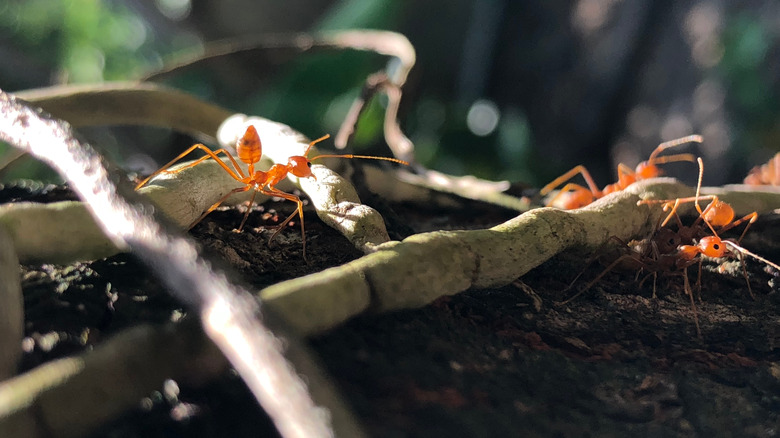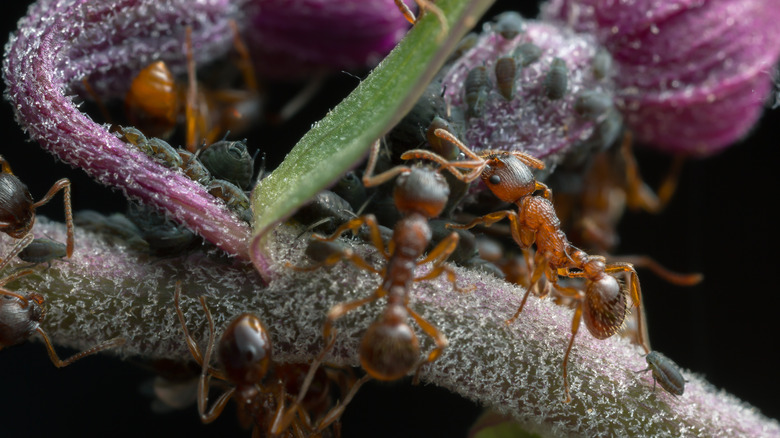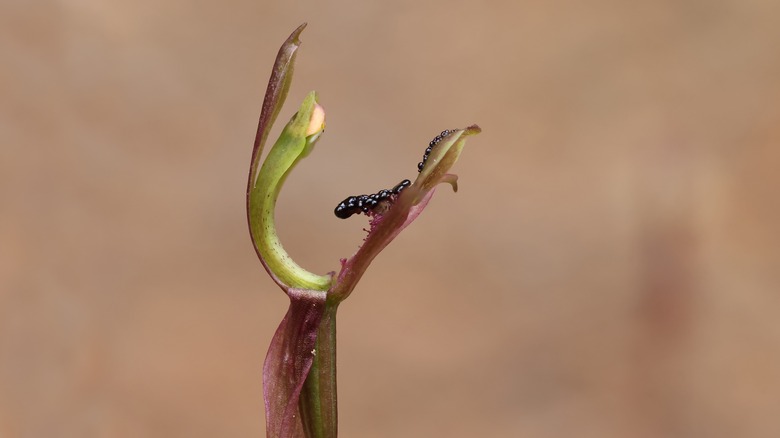Here's What's Attracting Ants To Your Precious Orchid
You might think ants are attracted to your orchid to eat it. The actual reasons this insect gravitates toward your orchids are far more complex ... and way more interesting. Some orchids have a symbiotic relationship with ants, encouraging them to nest or feed from the nectar they excrete in exchange for pollination, nutrients, or defense. In other cases, ants use orchids as "grazing pastures" for leaf-sucking insect pests. Believe it or not, they quite literally farm these bugs to harvest the honeydew they excrete from their rear ends. It's getting all David Attenborough's "The Private Life of Plants" over here!
Even if you haven't personally experienced an ant infestation, it's probably on the cards in the not-too-distant future — whether you have a single orchid growing on your patio wall or are caretaking an elaborate orchidary. A Dave's Garden forum member laments the black ants that quickly infested a planter housing a much-loved Encyclia. It took just a few days for ants to start nesting in the roots of Houzz Garden Discussion user @ms_minnamouse's recently acquired epiphytic orchid. Way back in 2008, new orchid grower @lovemyorchids35 posted on Orchid Board that ants appeared to be eating her flowers, something other members quickly refuted. This is all anecdotal, of course. So what's the real story?
Sweet treats
Select insects, like aphids, whiteflies, mealybugs, and scale, prey on orchid leaves, flowers, and roots. They attach themselves securely to the plant, using their long, thin mouthparts to suck nutrients — called phloem sap — from it, like drinking a milkshake through a straw. The secretion they expel from their backside is sweet; it's the excess carbohydrates (or sugars) the insect can't convert into energy. Ants, as we all know, love sugar. A 2014 study published by The Royal Society found that a sugar-filled diet helps ants ward off illness. All that to say, they're attracted to the insects (and the honeydew they produce) as a food source. If you have these pest insects on your orchid, observe your plants. You'll likely see ants moving amongst them, harvesting honeydew from their entomological flocks. They'll even pick up and carry the insects onto the leaves and plants they're preying on.
Some orchid species (Cymbidium, Coryanthes, and ghost orchids, for example) have nectar-producing glands, called extrafloral nectaries, on their leaves and flowers. They provide a delicious sugary syrup to ants, which, in exchange, ward off plant-munching pests. On the part of the orchid, it's either a clever adaptation toward a symbiotic relationship or a lucky side effect of waste production. Dactylorhiza viridis orchids use their extrafloral nectaries for another purpose: reproduction. Ants tripping to the flowers for nectar get a dollop of pollen deposited on their heads, which they carry to neighboring flowers, pollinating each as they travel.
Other ant attractors
Orchid mixes are made from peat moss, perlite, and tree bark. Some orchids can be finicky plants, preferring instead to grow on pieces of driftwood or small cut logs and branches. Contained neatly in a pot and boasting ready-made tunnels, these loose mediums make for perfect ant nests. Coryanthes orchids take this further and grow pseudobulbs that attract nesting ant colonies as they age and dry out. The orchid supplies this home in exchange for defense and dispersal of its seeds. Myrmecophila tibicinis do the same.
Ants also like to nest inside similar hollow structures grown by the Panamanian orchid Caularthron bilamellatum. In this case, the orchid gets nitrogen from decaying dead ants and the excrement of live ants. Catasetums orchids and the Colombian bucket orchid Coryanthes macrantha, among many other species, mutualistically house ants in their roots, creating enormous "ant gardens."
A few orchids take advantage of an ant's exceptional sense of smell. In a 2011 study published in Alpine Botany, a University of Zurich researcher discovered that Chamorchis alpina, a tiny European alpine orchid, attracts select ant species to its flowers with an irresistible scent. The ants pollinate the flowers as they move between blooms. Quite a few orchids use mimicry to trick insects into fertilizing their flowers. In Australia, the orchid Leporella fimbriata produces a floret that a particular species of male flying ant finds irresistible. It resembles a female ant of the same species; the male attempts mating with it, pollinating the flower in the process.


